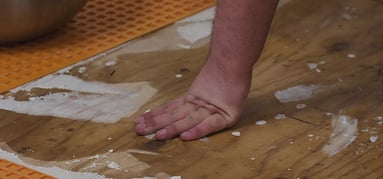Flooring jobs are common for contractors and subcontractors. Whether you’re completing the job for a homeowner or a commercial organization, it often involves work on the subfloor before you can get the new flooring installed. We recommend using the SCRAIL® SubLoc® PRO system—but more about that later.
For now, let’s discuss subflooring. Often, you can put down new flooring on top of an existing subfloor, but sometimes you’ll need to replace it before you can install the new floor. We’ll examine the issues that could lead to subfloor replacement.
1. Glue and Damage Caused by Removal
This is one of the big issues that will lead to the need to replace an entire subfloor. When you remove carpet, linoleum, or any other type of surface that has been glued down, the result can be messy. You’ll find not only old glue coating most of the surface, but also sometimes tears in the subfloor itself where mechanical removal of the flooring peeled up layers of plywood subfloor.
In these instances, it’s often best to just replace the subfloor entirely. Then you can start fresh with new flooring installed over a smooth, stable base.
2. Moisture Problems
Moisture damage manifests readily when the subfloor is exposed to water—mold, rot, mildew, expanded or flaking plywood or particle board, and so on. But even before you’ve removed the existing floor, you can often tell that subflooring will likely need to be replaced because of water damage.
If the ceiling has been leaking, for example, or if the space has a musty odor, those can be signs. Soft spots can be another indicator, and so can cracked tiles.
In kitchens, bathrooms, and other areas with plumbing, check around the fixtures. For instance, a loose toilet can be a sign that the subfloor beneath has started to sink, and that is usually because the toilet has developed a leak that has compromised the floor. Similar can happen beneath sinks, refrigerators, showers, and more.
3. Check for Popping Tiles and Shifting Floors
Floors should be solid—and when they’re not, the problem will either be the subflooring or the joists beneath. If the joists don’t have enough support, the floor can creak and groan when you walk across it. Hard-surface flooring like ceramic tile will certainly crack and pop on a floor like this.
If the joists have plenty of support, but the floor still shifts, pops, and creaks, then the subfloor is the problem. It may have weakened with age or there could be moisture problems that you haven’t yet spotted. Either way, replacement will be your best bet.
Install New Subfloors with SCRAIL® SubLoc® PRO
Whatever the causes for bad subfloors, when you need to replace them, you can’t go wrong with the SCRAIL® SubLoc® PRO system. This is an air gun system designed especially for subflooring. It relies on the SCRAIL®, which are fasteners that not only drive quickly and easily but can also be removed easily with a screwdriver or power drill. To learn more about it, check it out in the vide below!
.svg.png)

